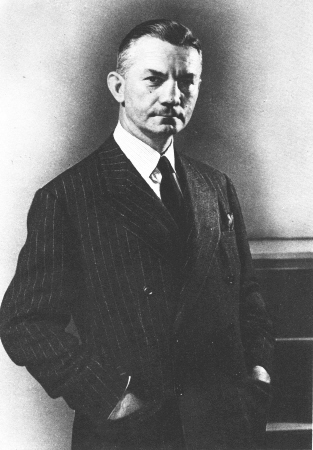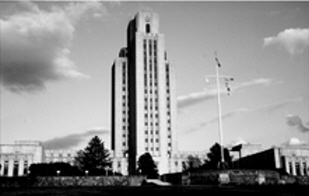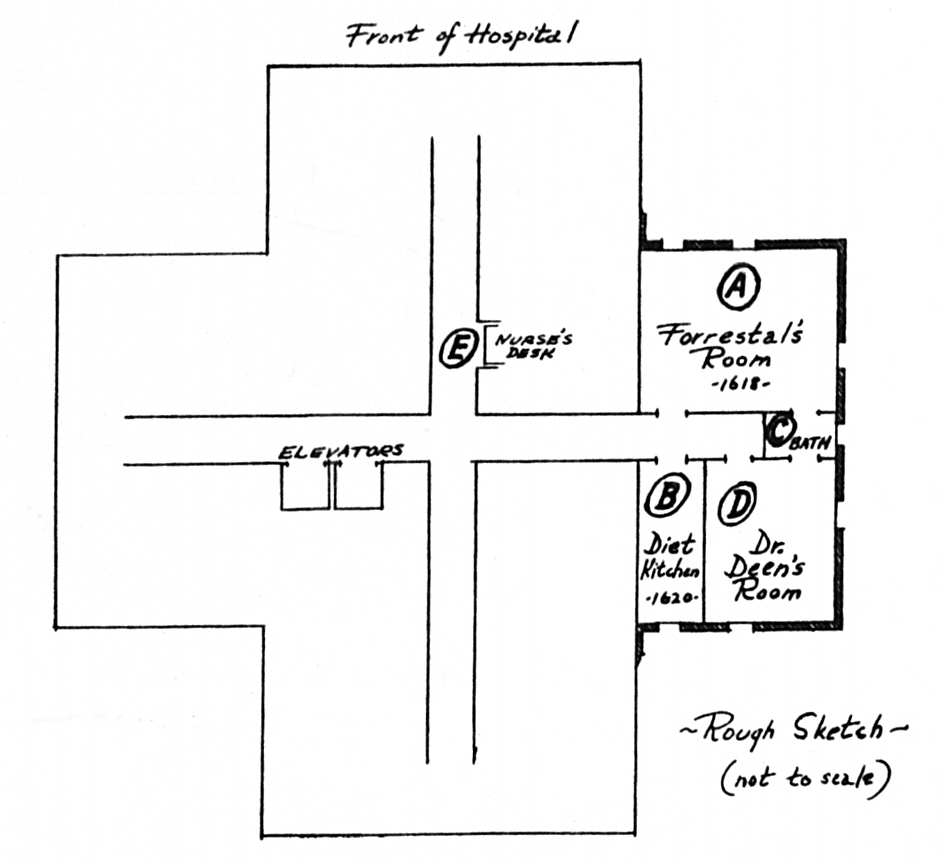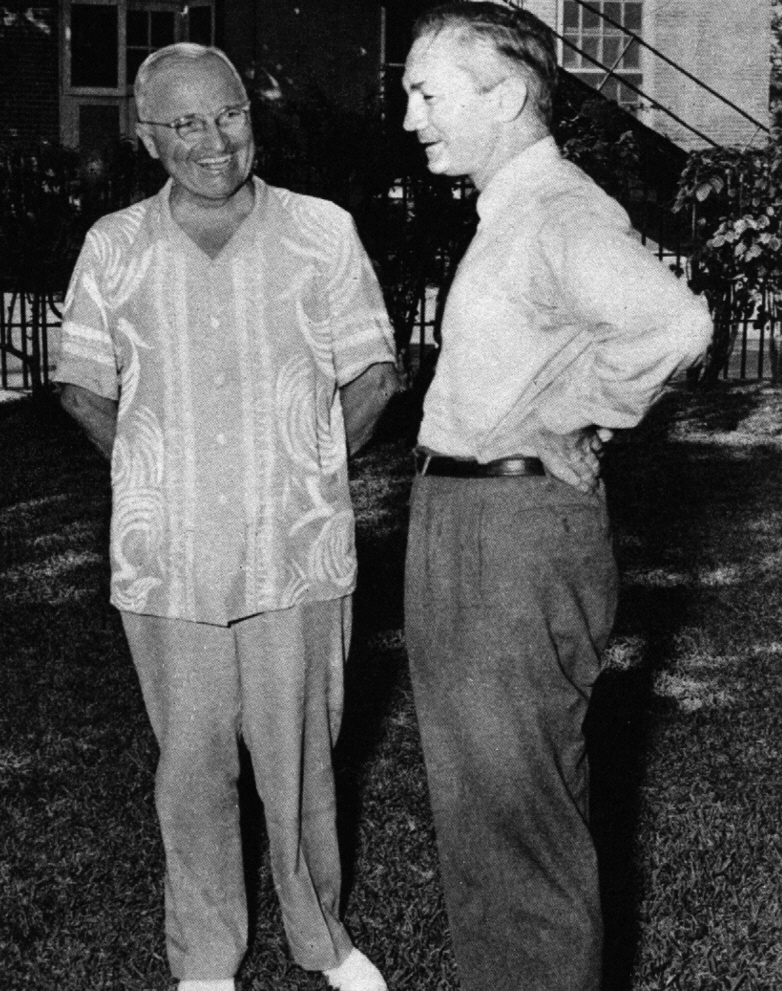T
he Death of James Forrestal
By Richard M. Dolan
copyright ©2001 all rights reserved
 This article is adapted from Richard Dolan’s
UFOs and the National Security State: Chronology of a Cover-Up, 1941 to 1973
,
Hampton Roads Publishing, 2002. It appeared in the December 2001/January 2002 issue of UFO Magazine.
This article is adapted from Richard Dolan’s
UFOs and the National Security State: Chronology of a Cover-Up, 1941 to 1973
,
Hampton Roads Publishing, 2002. It appeared in the December 2001/January 2002 issue of UFO Magazine.
At around 2 a.m. on the morning of May 22, 1949, America’s first Secretary of Defense, James Vincent Forrestal, fell to his death from a small window of the 16th floor of the Bethesda Naval Hospital.
The decline and death of Forrestal is an unresolved problem of history. There is no question that he suffered from a spectacular mental breakdown during 1948 and 1949. Exactly why he did so is less certain, but the answer may have relevance to American national security – and the pesky topic of UFOs.
From the standpoint of conventional history -- that is, sans UFOs -- there were no shortage of problems facing Forrestal. Throughout 1948, Forrestal locked horns with Air Force Secretary Stuart Symington over defense spending. Truman demanded an impossibly balanced budget, and Forrestal’s job was to keep the services in line. He could not do this and, to some degree, would not. The result was the erosion of Truman’s confidence. It may not have mattered to Forrestal: like most of the country, he assumed Truman’s political career was over and that by the end of the year a Republican, probably Thomas Dewey, would be in the White House.
But Forrestal, not Truman, was the doomed man. His relationship with Symington went from bad to worse. For reasons still unclear, Symington embarked, in the words of one author, "upon a kind of personal guerilla warfare" against the Secretary of Defense. Throughout the fall and winter of 1948, Forrestal’s mental health, physical condition, and authority as Secretary of Defense deteriorated. When Truman shocked the world in November by winning the Presidential election, Forrestal had still not obtained a budget consensus from the Joint Chiefs. Friends commented on his growing paranoia. He was convinced that "foreign-looking men" were following him, and that Symington was spying on him. Forrestal’s belief eventually came to the attention of Truman and Secret Service Chief U. E. Baughman, who decided that Forrestal was suffering from "a total psychotic breakdown."
On January 11th, 1949, Truman informed Forrestal that Louis Johnson would soon replace him as Secretary of Defense. By now, Symington and Attorney General Tom Clark were feeding stories to journalist Drew Pearson, in particular that Forrestal complained of "being followed by Jews or Zionist agents." Forrestal accused Clark of having the FBI shadow him, which Clark denied, but which according to all of Forrestal’s biographers could well have been true. Forrestal finally left office in a formal ceremony on March 28th, his last public appearance.
What followed after the ceremony remains mysterious. "There is something I would like to talk to you about," Symington told Forrestal, and accompanied him privately during the ride back to the Pentagon. What Symington said is not known, but Forrestal emerged from the ride deeply upset, even traumatized, upon arrival at his office. Friends of Forrestal implied that Symington said something that "shattered Forrestal’s last remaining defenses." When someone entered Forrestal’s office several hours later, the former Secretary of Defense did not notice. Instead, he sat rigidly at his desk, staring at the bare wall, incoherent, repeating the sentence, "you are a loyal fellow," for several hours.
|
|
9/18/47: Stuart Symington sworn in as the nation's first Secretary of the Air Force. Forrestal looks distracted.
|
Forrestal was taken home, but within a day the Air Force flew him to Hobe Sound, Florida, home of Robert Lovett (a future Secretary of Defense). Forrestal’s first words were "Bob, they’re after me." He met with Dr. William Menninger, of the Menninger Foundation, and a consultant to the Surgeon General of the Army. Captain George N. Raines, chief psychologist at the U.S. Naval Hospital at Bethesda, soon arrived. It is not exactly clear what transpired during Forrestal’s brief stay in Florida. One story from Pearson was that Forrestal had several hysterical episodes and made at least one suicide attempt, certain that the Communists were planning an imminent invasion. Menninger explicitly denied this. He did say that upon his arrival, Forrestal told him that the day before, "he had placed a belt around his neck with the intention of hanging himself, but the belt broke." But Menninger found no marks on Forrestal’s neck or body, nor did anyone find broken belts of any kind. Menninger considered Forrestal’s claim to be a nightmare. That’s about all we can know for sure.
On April 2, 1949, "for security reasons," Forrestal’s coterie flew him to Bethesda. During the trip from the Air Field to the hospital, Forrestal made several attempts to leave the moving vehicle, and was forcibly restrained. He talked of suicide, of being a bad Catholic, and several times of those "who are trying to get me." He was admitted to Bethesda under care of Raines, who diagnosed Forrestal’s illness as Involutional Melancholia, a depressive condition sometimes seen in people reaching middle age, often who saw their life as a failure. Upon arrival at Bethesda, Forrestal declared that he did not expect to leave the place alive. In a highly unusual decision for a suicidal patient, Forrestal’s doctor was instructed by "the people downtown" (e.g. national security) to place him in the VIP 16th floor suite
Meanwhile, Forrestal’s personal diaries, consisting of fifteen looseleaf binders totaling 3,000 pages, were removed from his former office and brought to the White House, where they remained for the next year. The White House later claimed that Forrestal had requested for Truman to take custody of the diaries. Such a claim, frankly, is preposterous. Throughout 1948, Forrestal had become increasingly alienated from Truman. Prior to the election, he had even met privately with leading Republicans to help insure his future with the Dewey administration.
|
|

Bethesda Naval Hospital |
|
Truman then abruptly fired him in favor of Johnson, a man plainly not qualified for the job. Forrestal’s diaries contained sensitive information that Truman’s people needed to know about. Presumably they had ample time to review them during the seven weeks of Forrestal’s hospitalization. |
Throughout Forrestal’s hospitalization, access to him was severely restricted. One-time visitors were his wife, his two sons, Sidney Souers (a former DCI, NSC executive secretary, and alleged MJ-12 member), Louis Johnson, Truman, and Congressman Lyndon Johnson. Menninger visited twice. Although Forrestal was presumably glad to see his sons, he was not close to any of these visitors, and had a political antipathy to his government colleagues who came by. However, Forrestal was not permitted to see the several people he continually asked to see: his brother, a friend, and two priests.Henry Forrestal, for example, repeatedly tried to see his brother but was refused until he threatened to tell the newspapers and sue the hospital. Ultimately, he was able to visit his brother four times. Henry told Raines and the hospital’s commandant, Captain B. W. Hogan, that his brother wanted to talk with a close friend, Monsignor Maurice Sheehy. Hogan replied that he was aware of this, but still would not allow it.Indeed, Sheehy had tried seven times to see Forrestal. Each time he was told his timing was "not opportune." (What kind of hospital policy denies a patient the right to see a priest, minister, or rabbi?) Sheehan, a former Navy chaplain, argued several times with Raines, and had the impression that Raines was acting under orders. Another priest, Father Paul McNally of Georgetown University, was also barred from seeing Forrestal, as was at least one other (unnamed) friend of the former Secretary.
Still, by May, Forrestal was improving. When Henry finally got to see him, he thought his brother was "acting and talking as sanely and intelligently as any man I’ve ever known." On May 14, 1949, Raines decided that he would leave Washington in four days to attend a meeting of the American Psychiatric Association. After their last meeting on the morning of the 18th, Raines wrote that Forrestal was "somewhat better than on the corresponding day of the preceding week." Forrestal continued in good spirits throughout all of the 20th and 21st. He showed no signs of depression, was well dressed, shaved, and in good appetite.
But the more Henry Forrestal thought about his brother being shut up at Bethesda and denied the right to see Father Sheehy, the more it bothered him. He decided he was going to take his brother to the countryside to complete his recovery, and made train reservations to return to Washington on May 22. He also reserved a room at the Mayflower Hotel for that day, then phoned the hospital to announce that he would arrive on May 22 to take his brother.He was too late.
The official account of Forrestal’s death runs as follows. During the night of May 21/22, Forrestal was awake at 1:45 a.m., copying a chorus from Sophocles’s Ajax from a book of world literature. (The New York Times added that Forrestal had been asleep at 1:30, then awake at 1:45.) A Navy corpsman named Robert Wayne Harrison, Jr., responsible for guarding Forrestal’s room, checked in, as was his job every fifteen minutes. Forrestal told Harrison that he did not want a sedative, as he intended to stay up late and read. Harrison reported Forrestal’s refusal to the psychiatrist – Raines’ assistant, Dr. Robert Deen – sleeping next door. They returned five minutes later to an empty room. Deen later claimed that Forrestal had sent Harrison out on a "brief errand." During this time, Forrestal walked to the diet kitchen across the hall, tied one end of his bathrobe cord to the radiator, the other end around his neck, removed a flimsy screen, and jumped from the 16th floor. The cord came untied, and he fell to his death after hitting part of the building on the way down.
Forrestal’s most recent biographers discounted the possibility of murder, calling the Secretary’s death "a series of chance events." Yet, discrepancies in the official suicide story were never clearly resolved, and several people close to Forrestal did not believe it. A biographer of Forrestal writing in the 1960s, noted that "even now . . . certain details have not been made public," and that some believed Forrestal’s death to be "very much desired by individuals and groups who, in 1949, held great power in the United States." Others went further, and maintained that Forrestal was murdered. Henry Forrestal, for one, believed strongly that "they" murdered his brother – they being either Communists or Jews within the government (Henry considered the Jewish connection because Forrestal’s geopolitics gave him a pro-Arab disposition).
Father Sheehy had reason to suspect murder. When he arrived at Bethesda Naval Hospital after learning of Forrestal’s death, an experienced-looking hospital corpsman approached him through the crowd. In a low, tense voice he said: "Father, you know Mr. Forrestal didn’t kill himself, don’t you?" Before Sheehy could respond or ask his name, others in the crowd pressed close, and the man quickly departed.
There are several odd elements concerning Forrestal’s final moments. First, the young corpsman guarding Forrestal – that is, Harrison – was a new man, someone Forrestal had never seen before. The regular guard during the midnight shift was absent without leave and, the story goes, had gotten drunk the night before. Harrison was the only person to have had direct contact with Forrestal in the moments before his death, and ultimately it was on his word only that the official account rested.
Also, Forrestal never finished writing the chorus from Sophocles, and in fact stopped in the middle of a word. Quite possibly, Forrestal had not even written the fragment that evening, especially if he had been asleep at 1:30 a.m. How reasonable is it to suppose that, sometime between 1:30 a.m. and 1:45 a.m., he woke up, got out some writing material, located a bleak poem within a huge anthology, copied out 17 lines, put on his robe, crossed the hall to the diet kitchen where he tightly wrapped and knotted his bathrobe cord around his neck and presumably tied the loose end to the radiator under the window; then climbed up on the window sill and jumped.
There is also an odd juxtaposition of a tightly knotted bathrobe cord around Forrestal’s neck and the assumption that he tied the other end so loosely to a radiator that it immediately came untied and allowed him to fall to his death. This radiator was a rather improbable gallows: it was about two feet long, the top was six inches below the sill, and it was attached to the wall with its base a good fifteen inches above the floor. But there was no evidence that the bathrobe cord had ever been tied to the small radiator in the first place. If the cord had snapped under Forrestal’s weight, one end would have been found still fastened to the radiator. The cord did not break, however, and there was not a mark on the radiator to indicate it had ever been tied there.
Moreover, if Forrestal wanted to hang himself, why choose a tiny window by anchoring himself to a radiator when he much more easily have done the job from a door or sturdy fixture, such as the shower curtain rod in his own bathroom? On the other hand, if Forrestal wanted to go out the window, why bother with a cord? Why not simply jump, a far easier proposition? In sum, we do not know that the cord was ever tied to the radiator, but we do know is it was tied tightly to Forrestal’s neck.
Later inspection found heavy scuff marks outside the window sill and cement work. Proponents of the suicide theory claim these were made by Forrestal’s feet while he was hanging by the neck from the |

Drawing of the 16th Floor of the U.S. Naval Hospital at Bethesda. Forrestal's room (A) shared a bath with his supervising doctor; he fell through a small, unsecured, window in the Diet Kitchen (B).] |
|
radiator, and perhaps that he belatedly changed his mind and tried to climb back in. But the scuff marks confirm no such thing. They could just as easily have been made by his struggle with someone pushing him out the window. |
There are many other suspicious elements to this story, such as the decision to place Forrestal on the 16th floor. This was exactly opposite what medical opinion desired (the bottom floor of a nearby annex had been the first choice of his caretakers), but was pressed by unnamed individuals in Washington.Also, the official investigation of Forrestal’s death was as much of a sham as that of President Kennedy would be 14 years later. The hospital labeled his death a suicide before any investigation took place; the county coroner hurried over to confirm the hospital statements. In cases where there is even a slight possibility of murder, it is normal for a coroner to delay signing a death certificate until an investigation, an autopsy, and an inquest had been completed. This did not happen. Since the death occurred on a U.S. naval reservation, local police did not investigate. Instead, the head of the naval board of inquiry immediately announced he was "absolutely certain" that Forrestal’s death "could be nothing else than suicide."
If we concede the possibility of murder, we must ask who and why? One can hardly credit the budget issue, which was settled by then and especially moot once Forrestal was out of office. One proponent of the murder theory blamed Communists within the U.S. government, or perhaps even the Soviet KGB/GPU. The reason, it was claimed, had to do with Forrestal’s diaries and plans for a book after his release from the hospital. Forrestal was an inveterate anti-Communist, and might have been perceived as problematic for agents of the Soviets. Moreover, the Soviets were no strangers to the art of staged suicides. Of course, neither were the Americans.
But there is at least one other avenue to consider.
UFOs constitute the great hole of contemporary history. We know, at the very least, that this was a topic of great concern to those at the top of American national security policy, despite the near-complete absence of public references to it. It is the proverbial elephant in the dining room that no one wishes to discuss. There are several reasons to consider a UFO connection to Forrestal’s death.
In the first place, Forrestal’s position within the defense community made him de facto a key player in the formulation of UFO policy. Because of the key importance, even urgency, associated with this topic in policy formulation during the late 1940s, we must assume that Forrestal was involved. The sensitivity of the UFO problem meant that Forrestal’s mental deterioration was a real security risk. One might even wonder whether Forrestal learned a truth about UFOs that contributed to his breakdown.
After all, consider the recent developments of the UFO problem for American national security policymakers. By 1948 (if not earlier, e.g. Roswell), it was becoming clear that the Soviets were not responsible for UFOs, and neither were the Americans. It was equally clear that well qualified military observers and equipment had tracked these objects at speeds and maneuvering capabilities that were impossible with contemporary technology.
In the spring of 1948, White Sands Proving Ground in New Mexico had been the scene of an extraordinary UFO sighting that was analyzed in secret by the Air Force Scientific Advisory Panel and security personnel at Los Alamos. The investigating team decided that UFOs were "of extreme importance."
That summer, another incredible case occurred, which resulted in the famed "Estimate of the Situation" stating the extraterrestrial thesis as an answer to UFOs. This was shot down by Air Force Commander Hoyt Vandenberg. Even so, President Truman began receiving regular briefings that summer on UFOs from his Air Force liaison, Colonel Robert Landry (coordinated with the CIA). Such briefings lasted through the remainder of his presidency.
By the end of 1948, the curious and unexplained "green fireball" phenomenon began appearing in very localized fashion over Los Alamos. This, too, received extreme levels of attention from America’s military and scientific elite, and did not (and do not) appear to be natural phenomena. In short, UFOs mattered a great deal within defense circles, and Forrestal was at the hub.
Secondly, Forrestal’s concern about being followed by "foreign-looking men" is a common description of the legendary-to-the-point-of-cliché Men in Black. He never stated clearly just who he believed to be following him, at least not consistently. Others assumed that he was talking about Communists, Jews, and Washington insiders, but they could only assume.
Then there is the disconcerting relationship with Air Force Secretary Symington. True, Symington considered Forrestal to be an enemy. But why, in the moment of Forrestal’s departure from politics, amid a spectacular psychological collapse, did Symington take it upon himself to have a secret conversation with Forrestal that left him utterly incoherent? This goes beyond mere conventional political maneuvering: what did Symington say – or do – to Forrestal? At least one senior military person linked Symington to a type of UFO "control group," and that was General Arthur Exon, former base commander of Wright-Patterson AFB, in an interview he gave in 1990. According to Exon, Symington was one of the "unholy thirteen," one of those who knew the most about Roswell. Forrestal, said Exon, was another.
An explanation centering on the UFO phenomenon accounts surprisingly well for the complete unhinging of a successful and brilliant individual, and more importantly, the need to silence someone who could no longer be trusted. Perhaps Forrestal’s psychological state was such that he did commit suicide. Although the facts of his death do not point toward this
|

Truman and Forrestal in Florida in 11/48, after Truman had won re-election. Truman's smile was real; Forrestal's wasn't.
|
conclusion, we do not have definitive knowledge, either. But consider the case of American journalist George Polk. A year before, Polk had been investigating corruption in the Greek military regime, elements of which then murdered him. The Communists were promptly blamed, while America’s intelligence and media communities knowingly went along with the charade. Or, just a few years later, in 1953, when American biological weapons expert Frank Olsen "fell" from the 10th floor of the Statler Hotel in New York City, after he had a very bad LSD trip, courtesy of the CIA, and had become a security risk.
During the bad old days of Stalin’s Russia, airbrushed photographs were a normal, if crude, way to sanitize history. American methods are less crude, but no less normal. |
Richard M. Dolan
2001